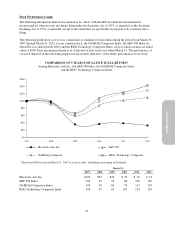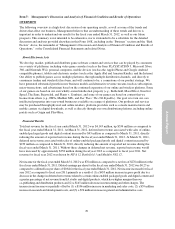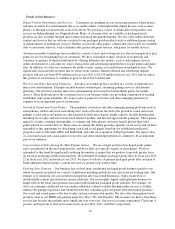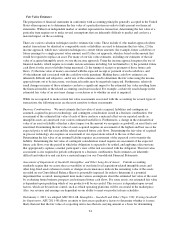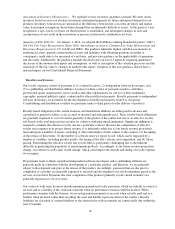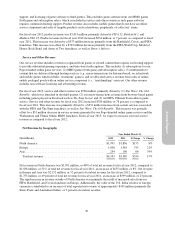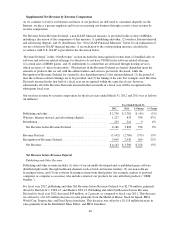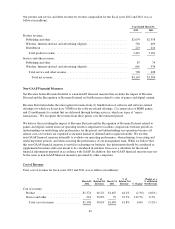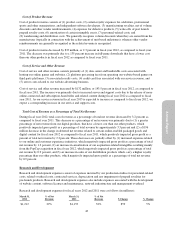Electronic Arts 2012 Annual Report Download - page 118
Download and view the complete annual report
Please find page 118 of the 2012 Electronic Arts annual report below. You can navigate through the pages in the report by either clicking on the pages listed below, or by using the keyword search tool below to find specific information within the annual report.Fair Value Estimates
The preparation of financial statements in conformity with accounting principles generally accepted in the United
States often requires us to determine the fair value of a particular item in order to fairly present our financial
statements. Without an independent market or another representative transaction, determining the fair value of a
particular item requires us to make several assumptions that are inherently difficult to predict and can have a
material impact on the accounting.
There are various valuation techniques used to estimate fair value. These include (1) the market approach where
market transactions for identical or comparable assets or liabilities are used to determine the fair value, (2) the
income approach, which uses valuation techniques to convert future amounts (for example, future cash flows or
future earnings) to a single present value amount, and (3) the cost approach, which is based on the amount that
would be required to replace an asset. For many of our fair value estimates, including our estimates of the fair
value of acquired intangible assets, we use the income approach. Using the income approach requires the use of
financial models, which require us to make various estimates including, but not limited to (1) the potential future
cash flows for the asset or liability being measured, (2) the timing of receipt or payment of those future cash
flows, (3) the time value of money associated with the expected receipt or payment of such cash flows, and
(4) the inherent risk associated with the cash flows (risk premium). Making these cash flow estimates are
inherently difficult and subjective, and if any of the estimates used to determine the fair value using the income
approach turns out to be inaccurate, our financial results may be negatively impacted. Furthermore, relatively
small changes in many of these estimates can have a significant impact to the estimated fair value resulting from
the financial models or the related accounting conclusion reached. For example, a relatively small change in the
estimated fair value of an asset may change a conclusion as to whether an asset is impaired.
While we are required to make certain fair value assessments associated with the accounting for several types of
transactions, the following areas are the most sensitive to these assessments:
Business Combinations. We must estimate the fair value of assets acquired, liabilities and contingencies
assumed, acquired in-process technology, and contingent consideration issued in a business combination. Our
assessment of the estimated fair value of each of these can have a material effect on our reported results as
intangible assets are amortized over various estimated useful lives. Furthermore, a change in the estimated fair
value of an asset or liability often has a direct impact on the amount we recognize as goodwill, an asset that is not
amortized. Determining the fair value of assets acquired requires an assessment of the highest and best use or the
expected price to sell the asset and the related expected future cash flows. Determining the fair value of acquired
in-process technology also requires an assessment of our expectations related to the use of that asset.
Determining the fair value of an assumed liability requires an assessment of the expected cost to transfer the
liability. Determining the fair value of contingent consideration issued requires an assessment of the expected
future cash flows over the period in which the obligation is expected to be settled, and applying a discount rate
that appropriately captures a market participant’s view of the risk associated with the obligation. This fair value
assessment is also required in periods subsequent to a business combination. Such estimates are inherently
difficult and subjective and can have a material impact on our Consolidated Financial Statements.
Assessment of Impairment of Goodwill, Intangibles, and Other Long-Lived Assets. Current accounting
standards require that we assess the recoverability of our finite lived acquisition-related intangible assets and
other long-lived assets whenever events or changes in circumstances indicate the remaining value of the assets
recorded on our Consolidated Balance Sheets is potentially impaired. In order to determine if a potential
impairment has occurred, management must make various assumptions about the estimated fair value of the asset
by evaluating future business prospects and estimated future cash flows. For some assets, our estimated fair value
is dependent upon predicting which of our products will be successful. This success is dependent upon several
factors, which are beyond our control, such as which operating platforms will be successful in the marketplace.
Also, our revenue and earnings are dependent on our ability to meet our product release schedules.
On January 1, 2012, we adopted ASU 2011-08, Intangibles – Goodwill and Other (Topic 350): Testing Goodwill
for Impairment. ASU 2011-08 allows an entity to first assess qualitative factors to determine whether it is more
likely than not that the fair value of a reporting unit is less than its carrying amount as a basis for determining
34





